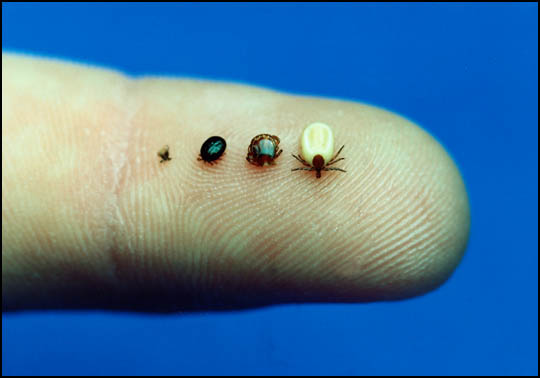Parasites are the ultimate opportunists, living on the skin, in the intestine and just about anywhere they can gain a foothold. Luckily, with the excellent veterinary preventive medicine programs available today, our dogs don't have to suffer parasitic infections any more.
Fleas
Fleas are the bane of a dog's existence. They make him itch, itch, itch. And the more a dog scratches, the itchier he seems to get. These irritating insects can cause itching in two different ways. First, they bite on a big chunk of skin and start sucking blood. They stay at one spot until they are full, or hop around, drinking at many different sites. Worse, they often bite in thin-skinned, sensitive areas such as near the ears, at the base of the tail, and in the groin area. Flea bites are irritating enough, but many dogs actually develop an allergic reaction to the saliva of the fleas, and they become extremely itchy all over, even with the bite of only one flea. Sometimes the allergy is so severe that a dog will chew at himself until he loses big patches of hair, bleeds, and ultimately develops thick, crusty skin, especially on his feet, at the base of his tail, and around his back legs.
If you see your dog scratching vigorously or biting aggressively at himself, it's time for a bug check. Start by looking around your dog's ears, at the base of his tail, and on his tummy. Part the hair and look for brown, flat, oval bugs about 1/8 inch long. Keep your eyes peeled because a startled flea can jump quickly into the air and land several inches away. Frequently you won't actually see a flea, but you can see flea dirt stuck in the dog's hairs. This "dirt" is flea excrement, a crumbly black material that consists mainly of digested blood. You can identify flea dirt by placing a drop of water over the dirt, letting it soak up the water for a minute or two, and then smearing the dirt on a piece of white paper towel. A reddish smear confirms that it is, in fact, flea dirt.
If you identify a flea or flea dirt, leap into action. The only thing that will give your dog relief is ridding his body and your house of those pesky pests. With the many safe anti-flea products that are available today, there is no longer any reason for your dog to suffer.
Fleas are especially fond of cats, so if you share your digs with an animal of the feline persuasion, be sure to include her in your flea prevention and treatment protocol.
Ticks
Ticks are major pests not only because they can bite your dog and cause local skin irritation, but because they carry a host of other pesky germs that can make both you and your dog sick. Ticks live on long grasses and shrubs, and they have a sticky substance on their bodies that enables them to easily cling to the fur of passing animals such as your dog. They then crawl down the hair to the skin and latch on, taking a big bite. They suck blood for hours and even days until they are full to bursting, as shown in Figure 1. During this time, they can transmit whatever infectious organisms they happen to be carrying.

Figure 1: From right to left: An engorged adult deer tick, an adult before attaching to the skin, an engorged nymph (young tick), a nymph before it has attached. Both adults and nymphs can transmit Lyme disease.
>
Photograph courtesy of Fred Dubbs
If you live in an area where ticks are prevalent (most of the United States except the Southwest and Alaska), it is important that you check your dog for ticks every day, at least during tick season (which is during the spring and summer months). Carefully remove every tick you find.
If your dog enjoys the outdoors (and most dogs do), apply a product that prevents ticks from attaching to the skin. Be sure to get advice from your veterinarian on which product is best, because new products enter the market all the time. Also, continue to check your dog from head to toe every time he comes in from outside. The places you're most likely to find ticks are around your dog's face, eyes, and ears, although they really can be anywhere. Be sure to look inside the ears, too!
Worms
Dozens of kinds of worms can set up shop in your dog's body, often in the intestine. Puppies are especially susceptible to infections with worms, because some species of worms are transmitted from the mother before the puppy is even born. This is why deworming puppies is so important.
The general level of care for our dogs these days is so high, however, that adult dogs rarely have problems with worms. Nonetheless, it is a good idea to bring a fecal sample to your annual veterinary visit for the first few years of your dog's life, just to be sure.
If you adopt a dog from a shelter or find a stray, be sure to have him checked for worms, because you won't know whether he has had adequate veterinary care from puppyhood.
>
dummies
Source:http://www.dummies.com/how-to/content/helping-your-dog-battle-fleas-ticks-and-worms.html
No comments:
Post a Comment